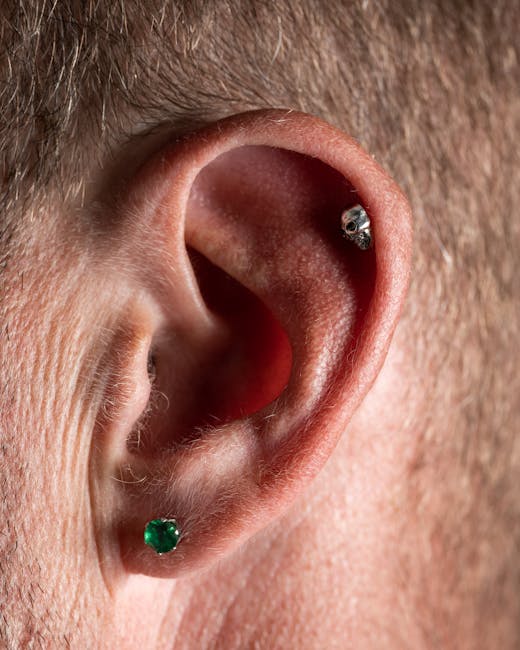Conch Piercing: A Comprehensive Guide to Placement, Aftercare, and Healing
The conch piercing, a captivating adornment nestled on the outer ear, has steadily climbed the ranks of popular piercing choices. Its unique location and versatility make it a statement piece for many, but understanding the nuances of conch piercing – from placement variations to meticulous aftercare – is crucial for a positive experience. This comprehensive guide delves into every aspect of conch piercing, ensuring you’re well-informed before taking the plunge.
Understanding Conch Piercing Anatomy
Before discussing the piercing itself, let’s clarify the anatomy. The term ‘conch’ refers to the deep, bowl-shaped part of the outer ear. There are actually several potential piercing locations within the conch, each with its own characteristics:
- Inner Conch: This piercing is located in the inner, deeper part of the conch. It tends to heal a bit faster than the outer conch due to its less exposed position.
- Outer Conch: Pierced in the outer, more prominent area of the conch. This spot is more visible and often chosen for its striking aesthetic, but it can take longer to heal and is more susceptible to accidental bumps.
- Anti-Conch: While technically not *in* the conch, this piercing resides on the opposite side of the ear, mirroring the conch’s shape. It’s often paired with a conch piercing for a balanced look.
Choosing the Right Conch Piercing for You
Selecting the perfect conch piercing involves careful consideration of several factors:

- Ear Anatomy: Not everyone’s ear is perfectly suited for every piercing type. A reputable piercer will assess your ear’s structure to determine the optimal placement and avoid potential complications.
- Desired Aesthetic: Think about your personal style and how you envision the piercing complementing your overall look. Do you prefer a subtle, understated look or a bolder statement?
- Jewelry Choice: Conch piercings accommodate a wide array of jewelry, from delicate studs to larger hoops and captive bead rings. The size and shape of the jewelry will influence the overall appearance.
- Healing Time: While healing times vary, be prepared for a commitment. Outer conch piercings, in particular, can take longer to heal.
Finding a Reputable Piercer
The quality of your piercing experience hinges on choosing a skilled and reputable professional. Don’t compromise on this crucial step! Look for a piercer who:
- Uses sterile equipment and techniques: This is paramount to preventing infection and complications.
- Is licensed and insured: This ensures they adhere to professional standards and have appropriate liability coverage.
- Has a clean and well-maintained studio: A hygienic environment is essential.
- Is knowledgeable about different piercing techniques and aftercare: They should be able to answer all your questions thoroughly and confidently.
- Provides detailed aftercare instructions: This is critical for successful healing.
Conch Piercing Aftercare: A Step-by-Step Guide
Proper aftercare is paramount to preventing infection and ensuring smooth healing. Follow these steps diligently:
- Cleanse the piercing twice daily: Use a saline solution (you can make your own or purchase pre-made) to gently clean the piercing. Avoid harsh soaps or alcohol-based cleansers.
- Avoid touching the piercing: Resist the urge to fiddle with the piercing or rotate the jewelry, as this can introduce bacteria and prolong the healing process.
- Keep the piercing dry: Avoid submerging the piercing in water, such as swimming pools or hot tubs, during the initial healing phase.
- Protect the piercing from irritation: Avoid tight-fitting hats, scarves, or clothing that could rub against the piercing.
- Be mindful of hair products: Keep hair products away from the piercing to prevent irritation.
- Monitor for signs of infection: Seek immediate medical attention if you notice any signs of infection, such as increased pain, swelling, redness, or pus.
Healing Time and Potential Complications
The healing time for a conch piercing varies depending on individual factors such as anatomy, aftercare, and body’s response to trauma. It typically takes anywhere from 6 to 12 months, with outer conch piercings often taking longer than inner conch piercings. Potential complications, though uncommon with proper care, include:
- Infection: Proper hygiene and aftercare are key to preventing infection.
- Keloid scarring: Keloids are raised scars, more prone in people with a predisposition.
- Rejection: In rare cases, the body may reject the piercing, causing it to migrate or become inflamed.
- Migration: The piercing may move slightly out of place over time.
Jewelry Choices for Conch Piercings
The beauty of conch piercings lies in the versatility of jewelry options. Popular choices include:

- Labret Studs: These are a classic and understated choice.
- Small Hoops: Offer a slightly bolder look.
- Captive Bead Rings: These are closed rings and look great on Conch Piercings.
- Circular Barbells: These are more modern and fashionable.
Remember to only use jewelry made of implant-grade materials, such as titanium, niobium, or 14k or 18k gold, during the healing phase to minimize the risk of irritation or allergic reactions.
Conch Piercing and Your Lifestyle
While conch piercings are relatively low-maintenance once healed, certain lifestyle choices may impact healing and longevity. For example, if you participate in contact sports, consider the risk of injury to the pierced area. Additionally, those who frequently wear headphones might experience minor discomfort during the healing phase.
Conclusion
The conch piercing, with its unique location and aesthetic versatility, offers a compelling way to express your personal style. By carefully selecting a reputable piercer, diligently following aftercare instructions, and understanding the potential healing challenges, you can enjoy this captivating piercing for years to come.


